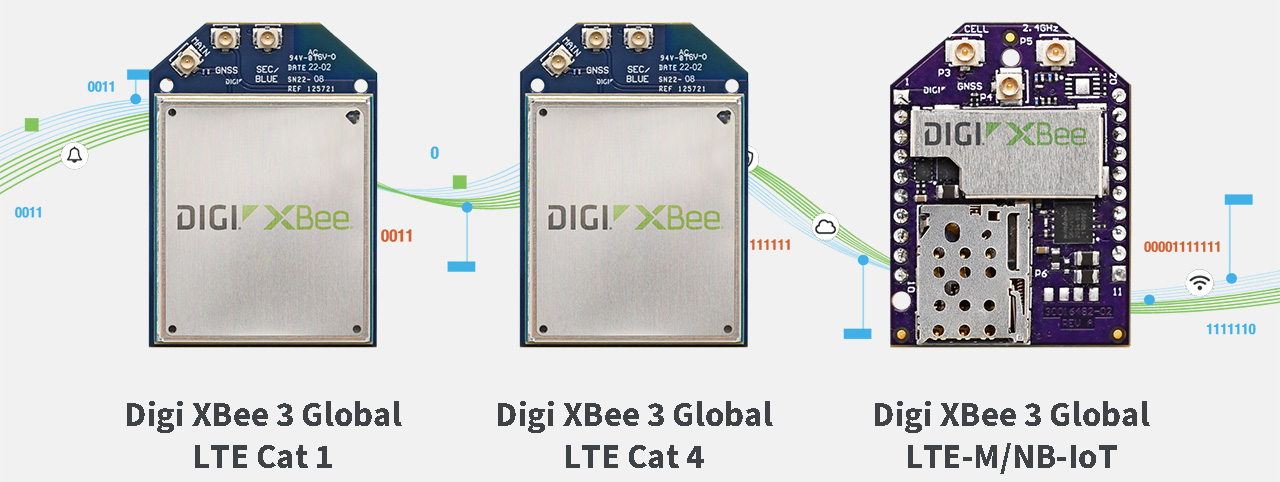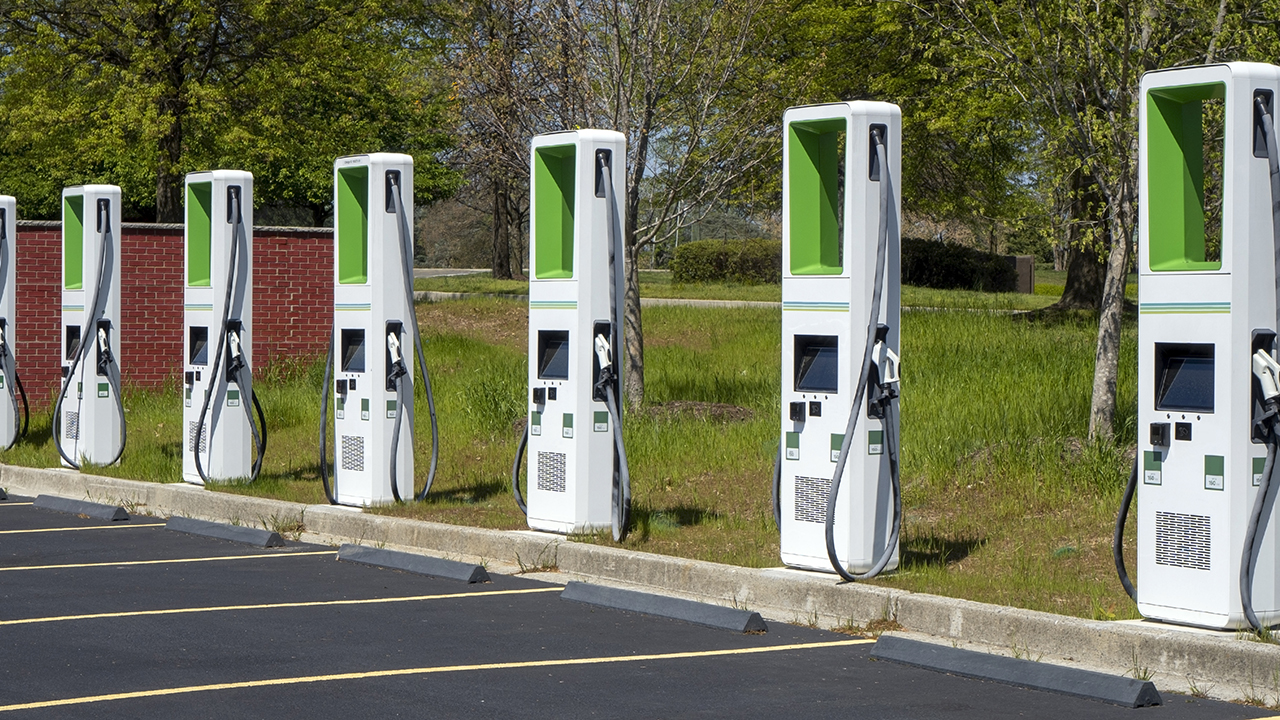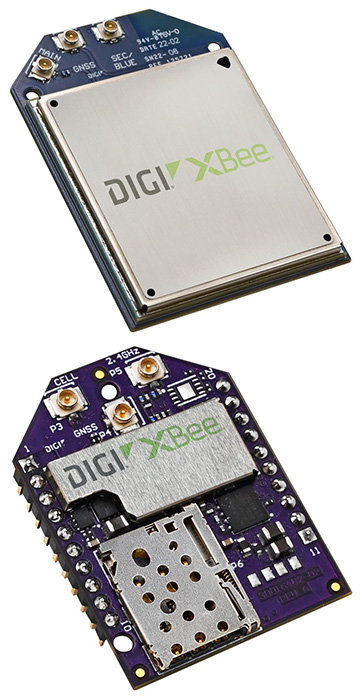Whether you’re building applications for industrial, medical, agriculture, transportation, utilities or another industry, you’re likely to spend lots of time integrating cellular modems and RF modules into OEM IoT devices. Regardless of location and the application, you want easy connectivity. That’s where the Digi XBee® Cellular LTE modem product line can help.
In this article, we’ll introduce the Digi XBee ecosystem and show how easily you can get started with our robust offerings designed for the toughest conditions. Digi XBee Cellular is part of this extensive ecosystem of supporting tools, code libraries, pre-certified modules, development kits, design and build services, and many more resources — all supporting rapid prototyping and development, quick time-to-market and complete product lifecycle management for a reliable and secure product.
Get the Datasheet
Learn about the capabilities and use cases of Digi XBee Cellular Cat 4
Download PDF
Digi XBee RF and Cellular LTE Modems: It's All in the Family
XBee® is a registered trademark of Digi International. The Digi XBee family of modules supports a range of popular wireless RF communication protocols, from mesh networking to 802.15.4 and LoRaWAN, as well as a range of cellular bands and technologies. Our growing Digi XBee Cellular LTE modem line supports cellular LTE Cat 1, LTE Cat 4, LTE-M and NB-IoT today. Millions of Digi XBee modules are deployed in a vast range of use cases across the globe, from agriculture applications to solar fields to a wide range of industrial use cases — and a growing number of those are cellular due to the ubiquitous nature and availability of cellular networks.
RF (2.4 GHz/900 MHz/868 MHz) vs. Cellular Communication: Which One Is Right for You?
Both XBee RF and cellular modules are excellent choices, depending on the parameters of your application. The pros and cons are fairly straightforward:
- RF communication modules are better suited to larger deployments, mostly due to cost considerations, since you do not need to pay cellular data costs for each individual module to communicate.
- However, there is more engineering and design required in building a local RF network than for a cellular network.
- Additionally, there are more failure points with RF. With an RF network, you're communicating across the whole network, getting data to a gateway, translating that gateway data and transmitting it to the Internet. Each of these steps must be engineered and verified.
- Cellular modems are the easiest and least complex to deploy. For example, since the LTE modem connects directly to cell towers, no gateway is required. Cellular also has the fewest rules and the lowest number of failure points.
- With cellular, you simply incorporate the module into your product, and you get connectivity.
An additional consideration is physical distance between nodes in your network. When you have a series of assets to connect within relatively close proximity to each other, perhaps within a thousand meters, you can use RF modules on a local network. When you have a few individual assets to connect, though, it is much simpler to use cellular.
So, let’s say you’ve decided to go with an embedded cellular modem or module, vs. an RF module. How do you select the right one for your application? Let’s discuss.
Selecting the Right Digi XBee Cellular LTE Modem
Generally, the right cellular technology is the one that's available at your deployment location. According to IoT Analytics, global cellular IoT connections surpassed 4 billion in 2024, and are expected to grow at a CAGR of 15% between now and 2030.
In China, NB-IoT has gained popularity while Japan, Australia and North America gravitated to LTE-M technology for lower-speed IoT installations. However, Europe embraced both NB-IoT and LTE-M. So, whatever country you're deploying to, find out if LTE-M or NB-IoT networks have been deployed by the carrier in that region.
LTE-M and NB-IoT are an excellent choice when you need to know the location of your assets and how long they’ve been there, but don’t necessarily need continuous updates. This passive asset tracking uses very little data.
In many cases, you will find higher-speed LTE networks such as LTE Cat 1 and LTE Cat 4 deployed globally. In fact, you may select the LTE Cat 1 and the LTE Cat 4 for their large global footprint, and not their speed, to ensure the best reliability when connecting to a network. LTE-M and NB-IoT have good network coverage. However, because these technologies require support from towers, only towers with updated software can host these networks. The U.S. probably leads most other countries in the world with tower software updates.
Digi XBee Cellular LTE Modems Compared

When looking at the suite of Digi XBee Cellular LTE modems, each of these options has some excellent features and capabilities for different applications.
- The Digi XBee 3 Global and Low-Power LTE-M/NB-IoT module combines the best of two worlds — with the ability to switch between LTE-M and NB-IoT — offering low-power cellular connectivity for edge applications while also supporting higher data rates, lower latency and cell tower handoff. It works great for asset tracking and mobile applications. Reasons to choose these modems:
- Battery powered devices
- Passive GNSS location
- Future-proof, as LTE-M/NB-IoT has been adopted into the 5G 3GPP specs
- Lowest-cost device
- Pre-certified Digi XBee 3 Global LTE Cat 1 modules are a great choice for several reasons. First, LTE Cat 1 is much more widely deployed than LTE-M and NB-IoT. Also, where LTE isn’t an option, Cat 1 also has 2G and 3G fallback, making it Digi’s most global modem. The Digi XBee LTE Cat 1 modem can switch between multiple frequencies and wireless protocols when needed. It works great for moderate bandwidth and low-cost IoT applications. Reasons to choose these modems:
- Active GNSS Location
- The most globally ubiquitous modem
- 2G/3G fallback
- Also comes in a North America variant that supports Band 14
- Digi XBee 3 Global LTE Cat 4 smart modems currently in development incorporates the same reliable Cat 1 hardware but supports higher speeds. Digi XBee Cat 4 modems make it easy to integrate higher bandwidth cellular connectivity into an OEM device. Reasons to choose these modems:
- Active GNSS Location
- The most globally ubiquitous modem
- Carriers prioritize higher speed modems, meaning this has the highest priority with the carriers of all the options
- 2G/3G fallback
- Great for integration with Digi ConnectCore® solutions
All Digi XBee 3 Cellular LTE modems come pre-certified for global cellular deployments. This means they help accelerate development times and remove the cost burden associated with carrier certification.
Cellular is essentially ubiquitous across the planet. And that's one of the reasons we Digi makes modules with fallback to the 2G and the 3G networks; they're more likely available in marginal coverage zones. With Digi XBee Cellular solutions, deploying cellular-connected assets is easy. And global. And flexible. And stable.
Example Applications for XBee Cellular LTE Modems
Cellular allows OEMs to remotely access equipment to improve insights and automation, and better service customers. In fact, customer service is a big selling point for IoT. Let’s look at some interesting applications for XBee Cellular modems.
Agriculture
Some of the key applications we see for cellular come from that vast agriculture industry.
 Agricultural equipment manufacturing: An equipment manufacturer may add cellular into its farm equipment for a couple of reasons:
Agricultural equipment manufacturing: An equipment manufacturer may add cellular into its farm equipment for a couple of reasons:
- It allows them to provide their customers with applications and subscriptions to access whatever chemicals or information they need, on command.
- The company may want to access analytics to learn how the equipment is being used in the field. For example, they may want to monitor usage patterns to help guide engineering. These insights can help to determine if customers are using all the capabilities and identify new features for later models to improve the design of their equipment.
- Silo and feed bin monitoring: Tracking content levels and other metrics is a common application in farming. Silo monitoring enables accurate monitoring of levels without the need to send workers up ladders, or manually enter in spreadsheets. In the case of feed bins, sensing bin levels and receiving notifications can help with inventory management and ordering.
- Irrigation: Cellular is an excellent choice for remote monitoring of soil and water sensors and irrigation pivots, as well as automation of watering processes.
- Precision agriculture: Precision ag encompasses a range of farming and agriculture processes, including automation, precise monitoring and use of fertilization and insecticide chemicals, and even self-driving tractors. Cellular is an excellent choice for these applications.
EV Charging and Service Stations
 Electric vehicle charging is one of the fastest growing industries, with the rapid growth of the EV market. Cellular in these applications supports data collection, financial transactions, user interface and video management and automation.
Electric vehicle charging is one of the fastest growing industries, with the rapid growth of the EV market. Cellular in these applications supports data collection, financial transactions, user interface and video management and automation.
In the service station scenario, one Digi customer used cellular communications to notify service personnel when coin-operated air pumps were full. Instead of sending a driver out to collect the coins from machines that might be mostly empty, IoT sensors and cellular applications detected the need for servicing and sent notifications. The system was so successful that the business was able to get a return on their investment within 9 months of deployment.
In addition to creating a more efficient collection system, the stations learned how the sites operated the machines and how customers used it even the locations with the most and least usage. As a result, they made changes to their offerings based on this new information — largely enabled by cellular communications.
Smart City Applications
 Today’s smart cities are looking for ways to reduce emissions and energy usage, lower their carbon footprint. Every city service that can be monitored remotely is a potential candidate for cellular modems – from smart street lighting to water and wastewater management services to trash compaction and sanitation systems.
Today’s smart cities are looking for ways to reduce emissions and energy usage, lower their carbon footprint. Every city service that can be monitored remotely is a potential candidate for cellular modems – from smart street lighting to water and wastewater management services to trash compaction and sanitation systems.
Finally, some companies use cellular communications to optimize their operations in ways that benefit the planet. For example, remote sensing enables companies to send fewer trucks, optimizing routes and sending trucks only when needed. By reducing truck rolls, intelligent IoT systems play an important role in reducing greenhouse gas emissions across all sorts of industries.
Learn More About Digi XBee Cellular LTE Modems
 There are industrial sensors and vast amounts of industrial equipment everywhere, but most of it is not connected today. What a tremendous opportunity for OEMs to build in IoT connectivity so their customers can start gaining new insights from operational data that can improve their business models or even inform new ones. That’s a big return on investment. It’s a digital transformation that elevates your organization above your competition. Ready to take the next step?
There are industrial sensors and vast amounts of industrial equipment everywhere, but most of it is not connected today. What a tremendous opportunity for OEMs to build in IoT connectivity so their customers can start gaining new insights from operational data that can improve their business models or even inform new ones. That’s a big return on investment. It’s a digital transformation that elevates your organization above your competition. Ready to take the next step?
Digi International, a leading provider of Internet of Things (IoT) connectivity solutions, has created the XBee Global Cellular family specifically as dependable, compact solutions with Bluetooth Low Energy and end-device carrier certifications. The modules were purpose-built to be used worldwide and are equipped with Global Navigation Satellite System (GNSS) positioning. Developers and original equipment manufacturers (OEMs) looking to add reliable cellular IoT connectivity to their devices or IoT gateways will find these solutions simple to implement and update.
To round out the ecosystem, Digi XBee Studio enables developers to design, build and test Digi XBee Global Cellular networks, and Digi Remote Manager® connects seamlessly to XBee Cellular LTE modems for remote monitoring, management and mass firmware updates. Finally, all Digi Cellular modems support MicroPython programming, Bluetooth, GNSS positioning for geolocation and Digi TrustFence® security.
Looking for a technology solution partner to help you design and build your IoT-enabled product? Digi can help. Our Wireless Design Services team of engineers will help you plan, procure and deploy your solution, regardless of industry or sector.
Get the Datasheet
Learn more about Digi XBee 3 Global LTE Cat 4
Download PDF
Digi XBee Cellular LTE Modem Applications FAQ
What types of applications are Digi XBee Cellular LTE modems used in?
Digi XBee Cellular LTE modems are commonly used in IoT (Internet of Things) and M2M (machine-to-machine) applications, including remote monitoring, smart agriculture, smart cities, industrial automation, environmental sensing, energy management, and asset tracking.
Can I use the Digi XBee Cellular LTE modem for remote monitoring?
Yes. The modem enables reliable cellular communication for remote monitoring systems such as water treatment facilities, oil and gas pipelines, or renewable energy sites. It allows data to be transmitted securely from remote locations to centralized systems.
Is the Digi XBee Cellular LTE modem suitable for smart agriculture applications?
Absolutely. Farmers and ag-tech providers use Digi XBee Cellular LTE modems to connect soil sensors, irrigation systems, and weather stations. This enables data-driven decision-making to improve yields, optimize water usage, and reduce operating costs.
How does the cellular modem support smart city solutions?
Digi XBee Cellular modems power connectivity for smart city applications such as connected streetlights, parking meters, waste management systems, and traffic monitoring. LTE connectivity ensures consistent performance across wide geographical areas.
Can the XBee Cellular modem be used for asset tracking and fleet management?
Yes. With LTE coverage, the Digi XBee Cellular modem is a strong fit for logistics, fleet tracking, and asset management systems. It provides reliable connectivity for GPS-enabled devices to transmit location, status, and usage data in real time.
Is the Digi XBee Cellular LTE modem appropriate for industrial automation?
Yes. It integrates seamlessly with industrial control systems and SCADA networks to support real-time data collection and automation. Applications include factory equipment monitoring, predictive maintenance, and control of remote industrial assets.
Does the XBee Cellular modem work in environmental sensing applications?
Definitely. Environmental monitoring systems (such as air and water quality sensors, weather stations, and wildlife trackers) leverage Digi XBee Cellular LTE modems to transmit data from remote or hard-to-reach locations to cloud platforms for analysis.
What role does it play in energy management and utilities?
The Digi XBee Cellular LTE modem is widely used by utility companies for smart grid applications, demand-response systems, and renewable energy installations. It helps utilities gather meter data, monitor distribution equipment, and improve service reliability.
Can the XBee Cellular modem be used in healthcare or medical devices?
Yes, in certain regulated applications. Digi XBee Cellular LTE modems can enable secure, remote connectivity for medical devices such as patient monitoring systems, emergency response equipment, and mobile healthcare solutions, provided compliance requirements are met.
What makes Digi XBee Cellular modems ideal for industrial applications?
Digi XBee Cellular modems have excellent features supporting security, scalability and more:
- Global LTE coverage for reliable connectivity
- Flexible design with the Digi XBee ecosystem and software tools
- Secure communication with built-in security protocols
- Scalability for everything from small sensor deployments to large-scale IoT networks
- Simple integration thanks to standardized XBee footprint and development tools
Next Steps